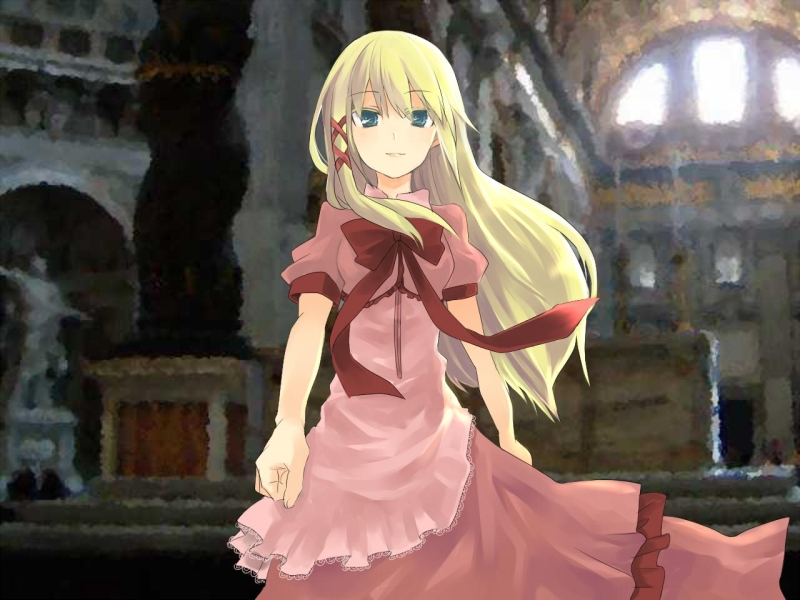
More people should read this.
This review may contain mild conceptual/structural spoilers to the work.
Ritterorden is a grounded, low-fantasy work. Reading through it provides a unique vibe: the feel of a ‘classic adventure’ fostered by a simpler scope & focus. The work is set in its original, vibrant universe – laden with politics, history, and culture. The plot and ensemble cast of characters, while well-crafted, are not revolutionary. Ritterorden is refined by a deliberate design philosophy, a standout soundtrack, and a meaningful central theme. Being a doujin work, its production quality is not ideal; but, does more than enough to make the most impactful, climactic moments memorable.
At the start of the work, the deuteragonist Crystal is traveling by wagon to the capital of Stiode (スティオード) when she is offered a slice of cake by Thermite, an attendant of the royal castle. Crystal is shocked, not because kindness is rare in Ritterorden’s universe. Indeed, Crystal observes that the prosperity of Stiode has made it amenable to peace & charity, as compared to its more barbaric, war-torn neighbors. The very wagon that Crystal was traveling on was a result of this kindness. Her surprise stems from cake being a complex treat, constituted of ingredients not ordinarily found outside of the castle – an exorbitant snack reserved for nobility. She graciously accepts. Later, when Crystal arrives in town, she hesitates going to a restaurant – not because she lacked the money, but because she surmised that the restaurant would not have the change for her silver coin (=~120 copper coins).
Ritterorden develops its complex, living world by introducing small quiddities, such as the above, into its writing. It develops its world by writing under the presumption that it has always existed – the reader simply learns more of the world by observation- frequently, through details such as the above, but also through more conventional methods of storytelling such as dialogue. The world which Ritterorden seeks to develop is massive – dynamics between the multifarious countries, each with their own ruling ethos, history, and culture are examined; some are doven deeper into, but much of the world feels vague – not for lack of effort, but for deliberate focus in scope (there’s absolutely more material for future installments; the depth of the world is comparable to the Kiseki series).

The plot of Ritterorden could be said to follow its general design philosophy; not being grand, but something of a cross section – a slice of its universe. On the surface, it revolves around Renatus Schmidt as he fulfills his duty as a knight of Stiode. Beneath that, Ritterorden could be construed as a tale of agency through which all of its characters – ‘good’ and ‘bad’, have to act to survive and steer fate in the desired direction. Many of its characters have darker, unfortunate pasts – some are resigned to them and meet their end accordingly; others fight – converting a past weakness to a future strength that serves them in achieving their personal goals. Ultimately, Ritterorden is good, not necessarily because of what it writes, but because of the method through which it tells its story; not through elegant prose, but through a pervasive, effusive worldview.
The above should not be conflated with the idea that Ritterorden is some dark, mature fantasy work (e.g. Game of Thrones). Ritterorden is very much a work of Japanese media – but it tows the line between being that more serious type of work, and being what it is quite well. It’s a work that uses its setting, not as a gimmick, but as an essential part of its storytelling. Miyakoda Yuusuke, the scenario writer, clearly has the knowledge ordinarily befitting the more mature type of work – he writes about military strategy, from composition to tactics; he writes of chivalry – from its abstraction to its disillusioned reality; and he writes of war – its effects on towns’ safety & economy.
Ritterorden is a work with a multi-route structure – there are four routes. Each route, with the exception of the first route, is well-paced and go on to develop the work’s core philosophies. The true route is the culmination, both in plot and theme, of all that came before it. There’s a pretty substantial rise in quality from the first route to everything that comes after it. The route order is:

Elisabeth (Princess) => Fine or Dominka => Crystal
Elisabeth’s route is a fever dream of nothing happening and the same song looping for hours on end – but the protagonist’s past gets developed (mildly). Fine’s route is more action-filled and involves directly confronting a conflict. Dominika’s route is tamer than Fine’s, but is just as well-paced; it involves de-escalating a conflict. Crystal’s route is the culmination of all the plot points developed – it leads to two possible endings. Both endings are good; one is darker, but oddly befitting – the other is ‘happier’, but just as fitting. When I read through this work, I was told by someone that there was a really cool track that only plays during the true route – around the final fight. I can confirm that the song does actually exist; but that an even more meaningful song plays during the ending credits (captures the grandeur of having summited a peak and seeing a sight few others have…)
Ultimately, I think that Ritterorden is a well-written work and is worth the read. The production quality is saved by its standout soundtrack and unique vibe – some might even say this adds charm to it. The production company’s name is Kimikakesou (君懸草). During the final route, Miyakoda writes about a flower named kimikakesou – a flower said to resemble a group of knights – a symbol of unity. It’s a beautiful flower – but is said to be highly poisonous – stem and petal all. Perhaps there’s something poetic about that description in relation to the work.

Nice review, already picking it up, but looking through the web to find a good guide and found nothing, so is there any good guide that you have or if not, a good hints for any importants choices, thanks..